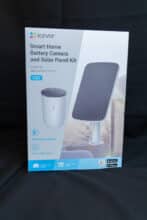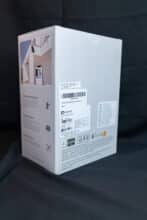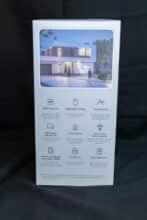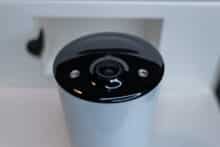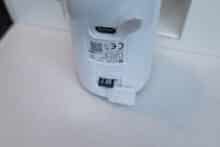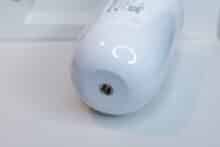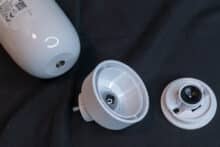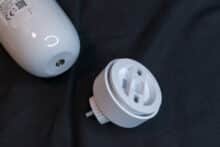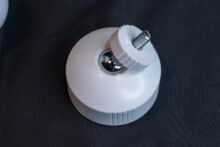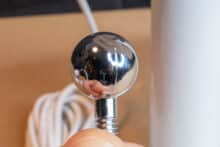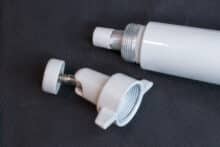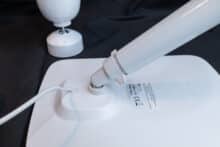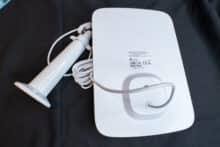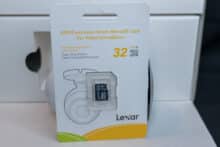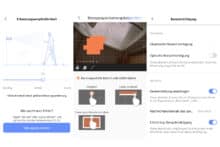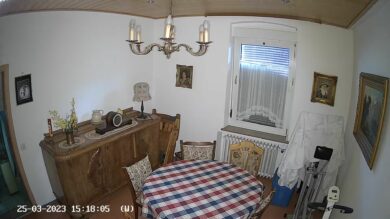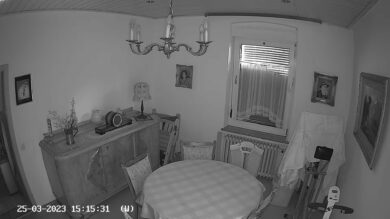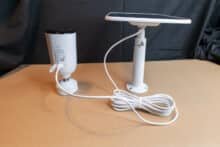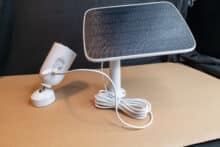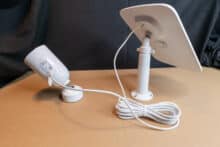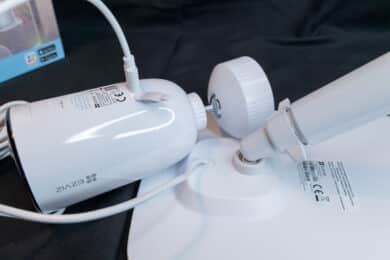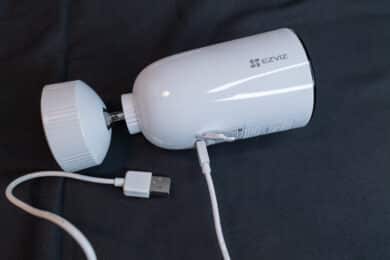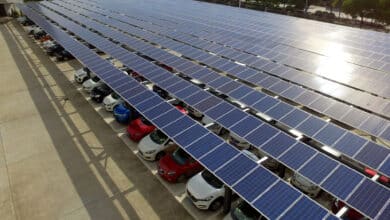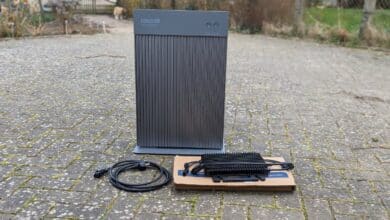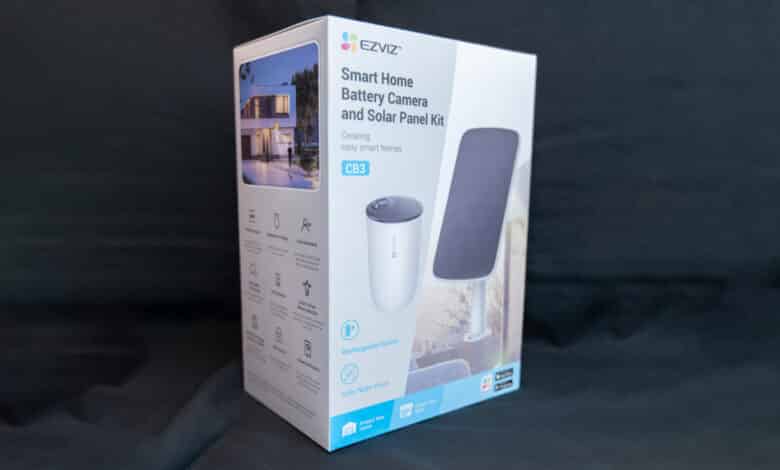
After introducing the wireless CB8, a swiveling outdoor camera with a large battery capacity, in September 2022, we would now like to introduce its little sister, the CB3 from EZVIZ. As a provider of outdoor and indoor video surveillance systems, EZVIZ offers a lot of cameras with a wide variety of features and capabilities.
Aside from not being able to pan them remotely, the less expensive CB3 offers a very similar feature set compared to the CB8. In combination with the (also optionally) available Solar Panel Kit, the CB3 even becomes a quasi self-sufficient surveillance solution for outdoor use, which again significantly reduces the maintenance effort.
For this article, we have tested in detail how reliably the CB3 worked in various scenarios and have also included a small comparison between the CB3 and CB8.
For our test, we were also provided by the manufacturer EZVIZ with a 32GB SD memory card from Lexar with high durability and read/write rate (UHS-I, Class 10), which is specially optimized for use in EZVIZ devices. In addition to this one, EZVIZ also has cards in 16, 64 and 128 gigabyte sizes in its lineup, which, like our specimen, are expressly suitable for permanent video recording.
Technical features of the EZVIZ CB3
| Model | CS-CB3 (1080P) |
| Product page | www.ezviz.com |
| Price | € 99.99 * |
| Camera | |
| Image Sensor | 1/2.9″ 2-megapixel progressive scan CMOS sensor |
| Minimum Exposure | 0.01 Lux @(F2.0, AGC ON), 0 Lux with IR |
| Shutter speed | Self-adjusting |
| Lens | 2.8mm @ F2.0 Angle of view: 128° (diagonal), 108° (horizontal), 56° (vertical) |
| Day and night | IR cut filter with auto switch |
| DNR | 3D DNR |
| Night vision function | Up to 15m |
| Video & Audio | |
| Max. Resolution | 1080p / 2MP, 1920 x 1080 |
| Image speed | Max. 15 BpS; Self-adapting during network transmission |
| Video compression | H.265 / H.264 |
| Video Bit Rate | Full HD; Hi-Def; Standard. Adaptive Bit Rate. |
| Audio Bit Rate | Self-adaptive |
| Max. Bit Rate | 1 Mbps |
| Network | |
| WLAN standard | IEEE802.11b, 802.11g, 802.11n |
| Frequency Range | 2.4 GHz to 2.4835 GHz |
| Channel bandwidth | Supports 20 MHz |
| Security | 64 / 128 bit WEP, WPA / WPA2, WPA-PSK / WPA2-PSK |
| Transmission rate | 11b: 11 Mbps, 11g: 54 Mbps, 11n: 72 Mbps |
| WLAN pairing | AP pairing |
| Protocol | Proprietary EZVIZ Cloud Protocol |
| Interface protocol | Proprietary EZVIZ Cloud Protocol |
| Minimum network requirements | 2 Mbps |
| Function | |
| Smart alarm | Intelligent human movement detection |
| Two-way audio | Supported |
| General function | Anti-flicker function, heartbeat, password protection, watermark |
| Memory | |
| Local memory | Supports MicroSD card (up to 256 GB) |
| Cloud storage | Supports EZVIZ CloudPlay storage (subscription required) |
| General | |
| Operating conditions | -20 °C to 50 °C, humidity 95% or less (non-condensing) |
| IP protection level | Weatherproof design |
| Power supply | DC 5 V / 2 A (adapter must be purchased separately) |
| Battery capacity | 5200 mAh |
| Current consumption | Max. 10W |
| Product dimensions | 105.9 × 62.8 × 62.8 mm |
| Packaging dimensions | 103 × 103 × 186 mm |
| Weight | 480g |

Scope of delivery of the bundle of CB3 and solar panel kit
- CB3 camera
- USB cable (50cm; USB-A to Micro-USB)
- 4.2W solar panel kit (4 meters micro-USB connection cable; hard-wired)
- 2x screw kit
- 2x drilling template
- Legal information
- 2x Quick Start Guide
Design and workmanship of the CB3
The CB3 is designed for outdoor use and is therefore weatherproof. The main openings of the camera’s plastic body, SD card slot and USB charging port, are tightly sealed by rubber-like bezels. Especially the front of the camera looks very classy due to the deep black and high-gloss plastic. The whole case is very well made.
The CB3 has a detachable mount, the base of which can be attached to the wall first. Once the base is firmly screwed to the wall, the camera and solar panel can be united with the base, making it much easier to attach. For this purpose, the CB3 has a standard 1/4 inch tripod thread (0.635mm) and a lock nut for fixing. The thread does not extend very deep into the camera.
Dowels are also included for mounting on plaster and stone.
We found an unsightly casting flash on the metal ball joint head of the CB3, which could affect the function of the ball joint, at least during installation. Also, the CB3 is not particularly practical to align via its ball joint.
The joint, and thus the CB3, can be aligned at a maximum angle of between 90 and 45 degrees to the wall in all directions. Whether or not this is sufficient for particular scenarios should be clarified before any drilling is done. Thanks to the ultra-wide angle lens of the CB3, however, house entrances, for example, can still be covered without any problems.
Workmanship of the solar panel
The solar panel also has a 1/4 inch tripod thread and is connected to its ball joint head via it, where it is initially fixed with a lock nut. Through this ball joint, the solar panel can then be freely aligned in all directions and finally locked with a large wing nut. However, as with the camera, this unfortunately doesn’t always work well right away.
The panel itself, like the CB3, is very well made. Its metallic wall mount is thickly coated with an enamel-like paint on the outside, making it look especially weather-resistant. 4 meters can be the distance between the camera and the solar panel, at least this is made possible by the micro-USB connection cable that is permanently connected to the solar panel.
It is worth mentioning that thanks to the tripod thread of both devices, other mounts for the camera and solar panel could theoretically be used. However, the solar panel’s micro-USB plug is extremely short and might therefore not be suitable for other devices, which we find extremely unfortunate. Its nature, on the other hand, virtually seals the CB3’s USB slot against rainwater intrusion.
The first setup of the EZVIZ CB3
Setting up the CB3 on the home WLAN works via the EZVIZ app, which must be installed on an Android or Apple mobile device for this purpose. From there, the big plus icon in the main menu takes you to the setup process. We set up the CB3 several times on different networks, and despite instructions and patience, it was not always as easy as one would like.
One circumstance that makes the process more promising is especially a small distance between camera, WLAN router and cell phone and thus a high signal strength. The camera should also be fully charged once beforehand using the charging cable.

After successfully connecting to the Wi-Fi network, the app recommends changing the default device password for security reasons, which can also be found on the camera itself.
At the very end, we can already make some settings on the CB3, such as the operating mode, which we set to “High Power”, and the range.
Formatting the inserted SD card
Following the setup, we are informed about the possibility to participate in the 30-day trial period of the manufacturer’s own storage service CloudPlay. A local alternative is an own micro SD card, which can be bought almost everywhere for a few Euros. If such a card is used, it should now be formatted because the device cannot record videos otherwise. The SD card can be formatted in the settings under “Recording list”. We have already used a 32GB SD card from Lexar, optimized for EZVIZ devices, which was provided to us by EZVIZ.
Settings via EZVIZ App
After setup, the camera is already functional and issues messages via app about detected movements. Via further settings, the CB3 can be adapted to the respective situation or personal requirements.
This starts with the aforementioned operating mode, which can be used to determine the rough length of recorded video clips from short to long or not at all. Individual time periods in which movements are not to be detected can also be created here.
In Intelligent Detection, you can choose between PIR infrared detection and “human body detection”. For both modes, you can also specify the sensitivity and image areas to be ignored.
Many customization options are offered by the notification settings. Like the CB8, the CB3 can make itself known acoustically with warning sounds and audio recordings, as well as visually with a built-in LED light, or remain completely silent.
The app will receive messages from the CB3 and send push notifications, but both can also be disabled. Recorded videos can be viewed via the library in any case. How soon after a message a new message is received from the CB3 can be determined via a message interval.
Finally, schedules can also be set up for app notifications, in which messages are issued or not. This can make sense, for example, if you are at home during the day on weekends anyway and therefore do not want to be notified.
If you also want to be notified by email about detected motion, you need to enable this in the EZVIZ app settings under the Email Alerts item.
Audio and image settings of the EZVIZ CB3
If the camera is to be placed outside, it might be appropriate to turn off the device’s voice prompts in the audio settings. By default, they are enabled. For example, voice instructions are given when the camera is first started up and set up.
The most interesting setting option in the image settings is the choice between color and IR night vision. This somewhat misleadingly named feature switches between built-in LED light to illuminate the scene and virtually undetectable infrared light. If the camera is to remain undetectable at night, the infrared night vision is the better choice here.
Manual operation of the CB3 via live view
Manual access to the camera and some of its functions is obtained via the live view in the app. Connecting to the live stream usually takes a few seconds. Snapshots and videos of the current livestream can be taken here. The zoom gesture, i.e. a movement with two fingers on the phone’s touch display, can be used to zoom in and out of the livestream. Up to 8x magnification of the image is possible.
If you have installed several devices in the EZVIZ app, you can switch to the next or last device by swiping left or right in the livestream.
If you want to set the resolution for the recordings, you can choose between Standard, Hi-Def and Full HD. Which resolution is best depends on the performance of the Wi-Fi network and the signal strength of the camera. If the Wi-Fi connection is poor, the app will inform you sooner or later.
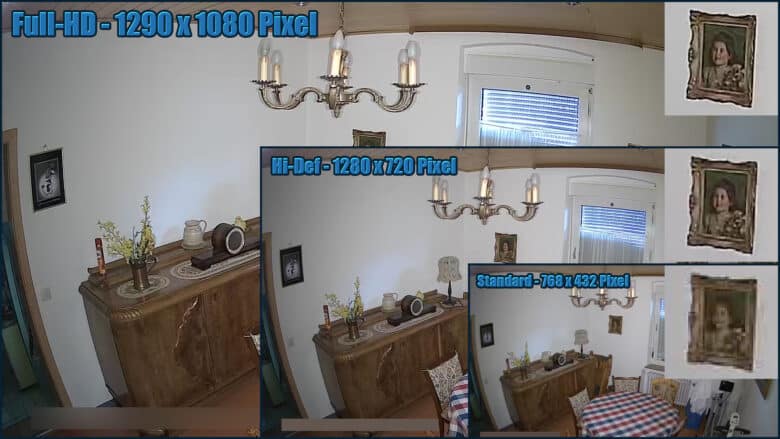
Microphone and speaker quality
Not directly adjustable is the quality of the audio track. The built-in microphone has a rather poor quality. This was no different in the test of the CB8 at the time and leads to the fact that recorded sound is hardly or not at all understandable depending on the situation, for example even in light wind, and thus cannot contribute to the further evaluation of the image material under certain circumstances.
In addition, two-way communication can be used in the live view, which records the user’s own voice on the mobile device and outputs it via the CB3’s built-in speaker in real time or with a slight delay. In this way, it is possible to talk to a person who can currently be seen in the live stream. The voice quality is limited by both the built-in speaker and the cell phone used, but was understandable in our test.
| Source device | Audio sample |
| CB3 integrated microphone | |
| CB3 integrated speaker | |
| Capacitor microphone |
Another small feature for the live view is a shrill alarm sound that can be turned on and off with the push of a button and definitely serves its purpose.
Automatic operation of the CB3
Whether or not the CB3 automatically records video when detected depends on the operating mode you set. In High Power and Power Save modes this is the case, only the length of the videos varies here. The length of automatically recorded videos cannot be controlled otherwise. If you want to put the camera into sleep mode, in which only the live view is accessible, you use the Extreme Power Saving operating mode. Schedules can also be created for the operating modes.
The second major factor for automatic operation is Intelligent Detection, for which both PIR infrared detection and human body detection modes are available. PIR detects thermal energy from humans and animals, according to the description; high temperatures can lead to false alarms in this case. Human body detection uses machine-learned patterns and is the default setting after initial setup. On the other hand, the selected night vision method, i.e. black and white or color, does not further influence the detection, but only serves the later viewer of the video material.
The test settings
We tested the CB3 for a while in High Performance mode and with human body detection at a sensitivity of 80. We selected an audible alarm and LED light as the device-side notification, and at the same time we had the detection output to our cell phone via push message. We set the message interval to one minute and the night vision mode to colored night vision with maximum light intensity. We tested the detection in both light and dark conditions. We were on the same network as the CB3 at all times during the test.
The result was satisfactory. When we entered the viewing area of the EZVIZ CB3, we were successfully detected in almost all cases. The detection was then issued by the EZVIZ app immediately or within a few seconds via push message to our cell phone, from which we were taken directly to the message and could view the recorded video. Alternatively, new videos can also be found in the library.
In some cases, the detection did not work. So, as a test, we set the sensitivity to 100, which improved the detection success rate. We could trick the CB3 in this mode by holding a sheet between us and it. No matter how violent our movements were, the camera did not react. Mere changes in the environment in the field of view did not necessarily lead to a message.
The PIR detection was more accurate in the test, even when only parts of the human body were visible. It was also much more difficult, if not impossible, to trick it. Whether higher temperatures would influence this accuracy, we cannot assess at this point.
The CB3 in comparison to the EZVIZ CB8
As a rigidly mounted camera, the CB3 offers less flexibility and at 5200 mAh also only half the battery capacity compared to the CB8 with 10400 mAh, but thanks to a 2.8mm lens it offers a 25-degree wider horizontal angle of view, which ultimately equates to a wider field of view.
While the CB8 houses a 3-megapixel sensor that captures 2304 by 1296 pixels, the CB3 gets by with a progressive 2-megapixel CMOS sensor and thus delivers a slightly lower resolution of 1920 by 1080 pixels (Full HD) at a maximum of 15 frames per second, depending on the connection speed.
The wireless network connection capabilities are the same for both models. At most, the CB8 requires 4 instead of 2 megabits per second in the network due to its slightly higher resolution. Both support the IEEE802.11b, 802.11g and 802.11n WLAN standards and frequencies from 2.4 GHz to 2.4835 GHz.
Many other features are shared between the two models, for example, both support smart person detection, two-way communication and the use of micro SD cards up to 256GB.
Those who already use the EZVIZ app can enjoy a relatively simple integration process, as EZVIZ devices can always be added to the app in the same way via QR code.
Security
On the topic of security, the EZVIZ app, for its part, already offers the now standard two-factor authentication and fingerprint login. A lost account can be recovered with a previously linked phone number.
The camera itself also has video encryption, which can also be turned off. As already described, it is also recommended to change the device password after setting up the CB3, which can be used to access the camera via app. After a reset, the CB3 can be used again with the printed password.
Automatically recorded video material that is on an installed memory card at this point is no longer accessible in case of theft. If you use the online storage offered by EZVIZ with a subscription, recorded data is still available there.
Videos and images that have been recorded manually via the live view are stored directly on the user’s own cell phone and are also not affected by any theft or defect of the camera.
Each camera registered in the app can be shared with other people via e-mail or phone number. Anyone who wants to access a device must install the EZVIZ app on their cell phone and have an account set up for it.
Battery power and solar panel
We tested the CB3 together with a solar panel kit from EZVIZ (go to product page), which is also optionally available.
Both are also available directly as a bundle, which we present in this article. Using the EZVIZ solar panel makes sense especially if you don’t want to manually charge the battery several times a year and dismantle the camera for it.
According to the manufacturer, the 5200 mAh battery alone can power the camera for up to 120 days, or 4 months, depending on usage. The combined use of the battery and solar panel with up to 4.2 watts of power enables the CB3 for low-maintenance continuous use, even during periods of low sunlight. Thanks to its generous micro-USB connection cable, the solar panel can be mounted up to 4 meters away from the camera and flexibly oriented in all directions to obtain the best possible solar yield.
If you want to charge the camera yourself, which makes sense immediately after purchase, you can do so using the included micro USB cable. However, a power adapter is not included in the scope of delivery, which is also indicated on the packaging. Due to the standardized charging infrastructure for small electrical devices, this should be a problem for most households by now.
A complete charging process via USB cable took a relatively long time in our case. To charge the battery from 20 to 100% capacity, we needed about 4 to 5 hours even with a quick charge socket.
When the CB3 is powered on and connected to the solar panel, this is indicated in the EZVIZ app. A sun is then added to the battery icon and the label shows “Charging by solar panel”.
In changeable spring weather with both diffuse and direct sunlight, we were able to charge 8 percent of our battery in an afternoon of about 6 hours (1 to 7 p.m.), which already exceeded daily consumption by a wide margin during normal use.
Conclusion
At the time of testing, the CB3 is available in the Solar Panel Kit Bundle for 129.99€ on Amazon (currently € 99.99 *), or 99.99€ due to 23% spring deals discount.
Both the CB3 and the 4.2W solar panel kit made a good impression in terms of workmanship and technically performed as promised. The solar panel provided more than enough power to offset the CB3’s daily usage, even in changeable weather. Its intelligent detection modes reliably triggered the recording depending on the sensitivity and situation and swiftly reported this to the app, where we received a push notification within seconds and could watch the message and the video.
A bit bumpy but ultimately always successful in each case was setting up the CB3 on a new Wi-Fi network. What also bothered us a bit were the wall mounts of both devices. In the end, they served their purpose, but we could have imagined more elegant technical solutions. The head of the ball joint for the CB3’s mount was also poorly manufactured and the joint itself does not allow as much freedom of movement as the solar panel.
As with the CB8 in the previous test, the microphone installed in the CB3 was also rather poor in quality. Sound recordings are thus hardly usable, especially in windy conditions.
The CB3 and EZVIZ app are otherwise rich in features and hardly leave anything to be desired. What we missed, however, was a download function for recorded videos.
Even at the normal price of around 130€ (99.99€ at the time of testing), we find EZVIZ’s CB3 solar panel combo recommendable on balance because it masters its basic functions. Once set up, the minor or major flaws hardly matter and even the poor sound quality does not detract from the actual gain in safety, thanks to reliable detection and quick reporting.
EZVIZ CB3
Workmanship
Hardware
Performance
Value for money
93/100
EZVIZ's CB3 and 4.2W solar panel combo was a reliable outdoor wireless video surveillance solution in testing, despite some weaknesses in various areas. The solar panel provided enough power to balance the daily consumption.


